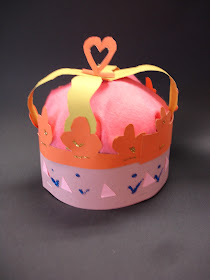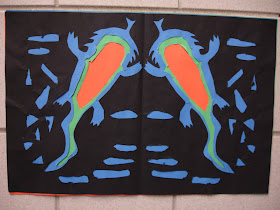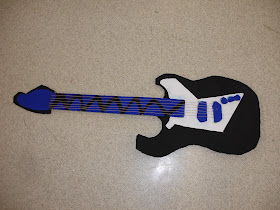5th grade students discussed a style of art called op art. Op art is not about what we see but HOW we see- a process called optics. The way our eyes try to make sense of an abstract image is the subject of Op art. Looking at the work of Bridget Riley we discussed how the various illusions were created using line, patterns, shapes and color. Students then used lines and value(lights and darks) to create their own op art. Here's some examples that students have just begun coloring!
Thursday, June 13, 2013
Name Aliens
This is one of my favorite end of the year drawing projects! Students begin by printing their name on a folded piece of paper. We then reflect their name across the fold by tracing it on the opposite side (creating symmetry). Once they have their name drawn in symmetry students were challenged to stretch their creative imaginations and transform their names into an alien! Looking at the results it's hard to see the original names!! Can you see them??
Monster Mouth!
Kindergarteners began this project by decorating a paper plate with patterns and textures. In the following class we looked at the story Where the Wild Things Are. Students were then challenged to transform their plates into their own Wild Things!
CROWNS
A recognition of honor or high status has always been displayed on the head. Miss Universe gets a tiara, a crown for royalty, a distictive cap for triban chieftans, a halo for saints....Second graders studied crowns from around the world, paying particular to their use of lines, shapes and patterns. Finally students set out to design their own crowns!
Molas
Mola is the Kuna Indian word for blouse or clothing. However, it is also the word used to describe the colorful panals made of cotton fabric created by the Kuna women of Panama that make up the front and back of a Kuna womans' shirt. Molas have become a part of the cultural dress of Kuna women, but they also create molas to sell to people all over the world! Third grade students discussed how molas are made and discussed the images typically found on them. Students then used paper to attempt their own molas. Each student chose an animal as inspiration and used symmetry to complete their design
Wayne Thiebaud Lollipops
Wayne Thiebaud is most remembered for his delicious looking paintings of food and desserts. Kindergarteners learned all about how Thiebaud used the elements of art to created these scrumptious artworks. We were particularly inspired by his images of lollipops. Students created their own lollipops using model magic.
Calder Wire Portraits
 While at the Museum of Fine Arts my fifth graders focused primarily on portraits. Upon our return to school I thought we could continue our portrait discussion by looking at an artist that approached them in a very differnt way--Alexander Calder. Calder is most remembered for his mobiles and stabiles but his portraits are also quite facinating. He used wire to create three dimensional drawings in space. He created many portraits of his friends or fellow artists as well as some popular figures such as Calvin Coolidge, and Babe Ruth. We discussed how he sometimes created almost a caricature of the person by exaggerating certain features. Students then used wire to create their own self portraits!
While at the Museum of Fine Arts my fifth graders focused primarily on portraits. Upon our return to school I thought we could continue our portrait discussion by looking at an artist that approached them in a very differnt way--Alexander Calder. Calder is most remembered for his mobiles and stabiles but his portraits are also quite facinating. He used wire to create three dimensional drawings in space. He created many portraits of his friends or fellow artists as well as some popular figures such as Calvin Coolidge, and Babe Ruth. We discussed how he sometimes created almost a caricature of the person by exaggerating certain features. Students then used wire to create their own self portraits!Wednesday, June 5, 2013
Chihuly Macchia
Kindergarten and first grade got in on the Chihuly action as well by designing their own Macchia. Macchia is Italian for spotted. Students discussed how Chihuly created these spotted organic sculptures using glass. We also discussed the differnce between shapes and forms. In order to create their own, stuents decorated a coffee filter. Using watercolor markers, they created patterns shapes and finally spots. The completed designs were attached to a plastic cup with a rubberband and sprayed with liquid starch. When the starch dried the cup was removed to created the form.
Finished Chihuly tower!!
We finished this tower a while ago and I forgot to post these pictures of it finally finished! This was definately my favorite project of the year. It's great to see what we can do when we all work together! It was extra exciting when I got to take the fifth grade class to the MFA to see a real Chihuly tower!
Klimt Trees
Fourth Graders looked at the work of Gustav Klimt. Klimt was inspired by the glittering mosaics he viewed in the Churches on a trip to Italy. Eventually, this led to Klimt using gold in his paintings. Students learned about the Art Nouveau style that Klimt was famous for- describing its characteristic features like curling vines, organic shapes based on plant forms, and flat repeated patterns. Finally we viewed his work Tree of Life which students used as inspiration for their art. Using gold paint students created their own stylized Art Nouveau tree.
Art Rocks!!!!!!!
 Fourth grade students studied the art of the guitar. Students looked at 4 centuries of guitar design and discussed why this instuments design has gone through more changes than any other. Students also described how changes in fashion, technology, and musical tastes influenced the design of this popular instrument. After viewing many examples from the past and present -students set out to design thier own guitars. We learned that the electric guitar could be shaped however the artist desired since the sound was not going to be affected by the shape. We viewed many examples of creative designs- like the flying V, a guitar shaped like a crutch, a moon, even one shaped like the USA! (to name a few...) Students began by sketching their own ideas and then created their guitars out of cardboard.
Fourth grade students studied the art of the guitar. Students looked at 4 centuries of guitar design and discussed why this instuments design has gone through more changes than any other. Students also described how changes in fashion, technology, and musical tastes influenced the design of this popular instrument. After viewing many examples from the past and present -students set out to design thier own guitars. We learned that the electric guitar could be shaped however the artist desired since the sound was not going to be affected by the shape. We viewed many examples of creative designs- like the flying V, a guitar shaped like a crutch, a moon, even one shaped like the USA! (to name a few...) Students began by sketching their own ideas and then created their guitars out of cardboard.












































